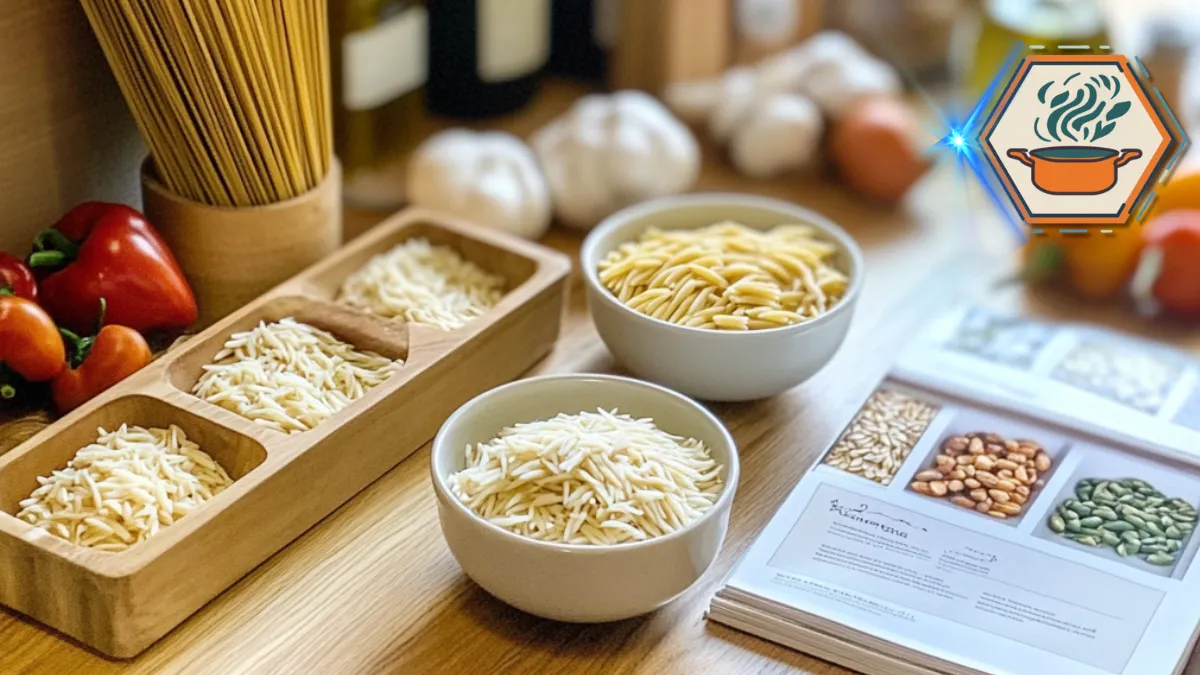Time to read:11 minutes
Table of Contents
Understanding Orzo and Traditional Pasta
When comparing orzo vs pasta, understanding their unique features is essential. Both are versatile and widely used in cooking, yet they differ in composition, texture, and applications. Let’s dive into what makes each of them distinct.
What is Orzo?
Definition and Origin
Orzo vs pasta begins with their shape—Orzo, a type of pasta, resembles grains of rice, perfect for soups, salads, and sides. Its name comes from the Italian word for barley, reflecting its resemblance to barley grains. Orzo vs pasta usage differs as orzo is a Mediterranean staple often paired with herbs and olive oil.
Orzo is often mistaken for rice because of its appearance. However, it is made from wheat flour, similar to other types of pasta. This makes it an ideal choice for soups, salads, and casseroles.
Fun Fact: Orzo is also called “risoni” in some regions, emphasizing its rice-like structure.
Nutritional Composition
Orzo contains similar nutrients to most pasta. A typical serving provides:
- Carbohydrates for energy
- Protein for muscle repair and growth
- Small amounts of fat
- Fiber, especially in whole-grain varieties
However, orzo is often enriched with iron and B vitamins. This makes it beneficial for maintaining healthy blood and energy levels. Whole-wheat orzo offers higher fiber content, supporting better digestion and keeping you full for longer.
What is Traditional Pasta?
Key Varieties
Traditional pasta includes a broad range of shapes and sizes. Some popular varieties are:
- Spaghetti: Long and thin strands, perfect for sauces.
- Penne: Tube-shaped pasta with ridges that hold sauces well.
- Fusilli: Spiral-shaped pasta often used in salads.
Each type serves a specific purpose in cooking. For instance, spaghetti pairs well with marinara sauce, while penne is excellent for baked dishes.
Nutritional Profile
Traditional pasta, like orzo, is made from wheat flour. It is available in refined and whole-grain options. Refined pasta is softer but lacks the fiber found in whole-grain varieties. Whole-grain pasta, on the other hand, provides:
- More fiber for improved digestion
- A lower glycemic index, which helps regulate blood sugar levels
- A nutty flavor, enhancing the taste of many dishes
Pasta is also commonly enriched with nutrients like folate and iron. These additions make it a good source of essential vitamins and minerals.
Key Differences Between Orzo and Traditional Pasta
While both orzo and pasta belong to the same food family, they differ in significant ways.
Texture and Preparation Methods
Orzo has a smooth and tender texture. It cooks quickly, usually in about 8–10 minutes. This makes it ideal for soups and salads. Its small size allows it to absorb flavors easily, making dishes more flavorful.
Traditional pasta, depending on the variety, requires different cooking times. For instance, spaghetti might take 10–12 minutes, while penne can take longer. The texture also varies, with options like al dente offering a firm bite.
For a comprehensive understanding of pasta, including its various textures and types, consider exploring Britannica’s article on pasta. This resource provides detailed insights into pasta’s history, preparation methods, and the diverse forms it takes in culinary traditions.
Versatility in Recipes
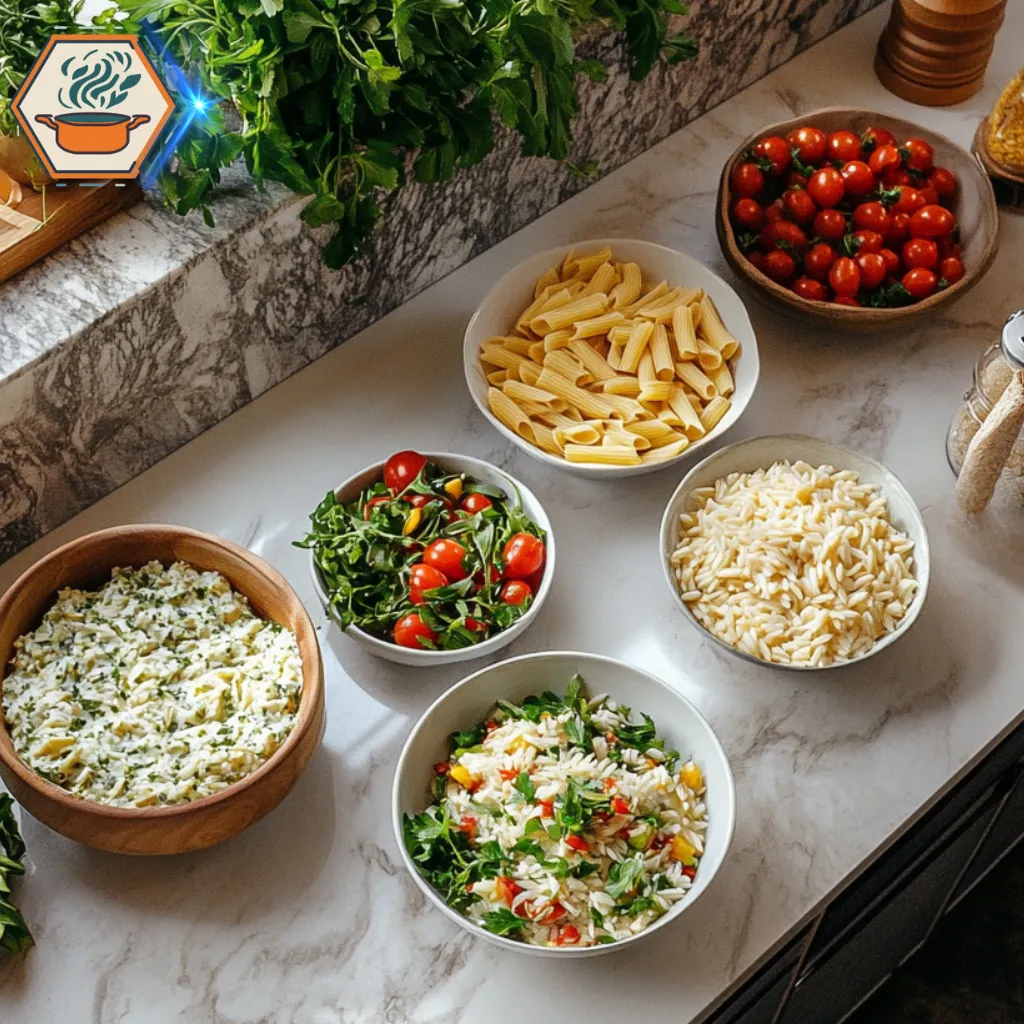
When comparing orzo vs pasta, orzo’s rice-like shape enhances its versatility in dishes like pilafs and risottos. You can use it as a substitute for rice in dishes like pilafs or risottos. It’s also a great addition to cold salads, paired with fresh vegetables and herbs.
Orzo vs pasta highlights pasta’s adaptability in saucy dishes like Bolognese and creamy lasagnas. It works well in:
- Saucy dishes like spaghetti Bolognese
- Baked recipes such as lasagna
- Light meals like pasta primavera
Both orzo and pasta can be used creatively in the kitchen. For inspiration, check out our Perfect Meatloaf Every Time recipe to pair with a hearty pasta side.
Nutritional Comparison of Orzo and Pasta
When choosing between orzo and pasta, understanding their nutritional profiles is essential. Both offer unique benefits, but they differ in macronutrient composition, fiber levels, and micronutrient content. Let’s explore these differences in detail.
Macronutrients Breakdown
Protein, Carbohydrates, and Fat Content
Orzo, often mistaken for rice due to its shape, is a versatile pasta made from wheat. It typically contains:
- Protein: Around 7 grams per 2-ounce serving, similar to regular pasta.
- Carbohydrates: Approximately 41 grams, making it a carbohydrate-rich choice.
- Fat: Minimal fat content, usually under 1 gram per serving.
On the other hand, traditional pasta varieties, whether spaghetti, penne, or fusilli, offer comparable macronutrients:
- Protein: 7-8 grams per serving.
- Carbohydrates: About 42-43 grams per serving.
- Fat: Like orzo, pasta has negligible fat content.
While the two are nearly identical in macronutrient composition, the type of flour used can alter the nutritional value. Whole-grain orzo and pasta provide additional nutrients compared to refined options.
Fiber Levels and Impact on Digestion
Fiber plays a crucial role in digestion and overall health. Whole-grain versions of orzo and pasta are higher in fiber than their refined counterparts:
- Whole-grain orzo: Provides up to 5 grams of fiber per serving.
- Regular orzo: Contains about 2 grams of fiber.
Similarly:
- Whole-grain pasta: Can have 6-7 grams of fiber.
- Regular pasta: Typically offers 2-3 grams of fiber.
Choosing whole-grain options helps improve digestion and supports heart health, making them ideal for those prioritizing wellness. For more ideas on healthy alternatives, check out our perfect meatloaf recipe.
Micronutrient Analysis
Vitamins and Minerals in Both Options
Orzo and pasta are rich in B vitamins like niacin and folate, essential for energy metabolism. However, the exact micronutrient content varies depending on whether the product is fortified:
- Orzo: Often enriched with iron and B vitamins.
- Pasta: Frequently fortified, especially in commercial brands, to include higher levels of iron and folic acid.
Whole-grain versions of both naturally contain magnesium, zinc, and selenium—all vital for immune function and bone health.
Fortified vs. Non-Fortified Varieties
Many orzo and pasta products are fortified to replace nutrients lost during processing. Fortified options are beneficial for individuals with specific dietary needs, such as pregnant women requiring folic acid. However, whole-grain versions often surpass fortified options in nutrient density because they retain their natural vitamins and minerals.
Calorie Content Comparison
Serving Size Impact on Caloric Intake
Understanding portion control is vital when comparing orzo vs. pasta. Both contain about 200 calories per 2-ounce serving. However, differences in density and shape can affect serving sizes:
- Orzo: Its small, rice-like shape makes it denser, often leading to higher caloric intake if not measured correctly.
- Pasta: Larger shapes like penne or spaghetti may appear more voluminous, encouraging smaller portions.
To manage caloric intake effectively, always weigh portions rather than estimating by eye.
Low-Calorie Options for Health-Conscious Eaters
For those aiming to reduce calories, consider alternatives such as:
- Vegetable-based pasta: Made from zucchini or lentils, these are low-calorie and nutrient-dense.
- Whole-grain orzo: Offers fewer calories per volume due to its higher fiber content, keeping you fuller for longer.
For tips on making nutritious dishes, explore our guide to milk in meatloaf for a creamy yet health-conscious meal.
Health Benefits and Drawbacks: Orzo vs Pasta
When comparing Orzo vs Pasta, understanding their health benefits and drawbacks helps you make informed dietary choices. Both orzo and traditional pasta are versatile, nutrient-packed, and satisfying, but they cater to different nutritional needs depending on preparation and portioning.
Benefits of Choosing Orzo
Light Texture for Easy Digestion
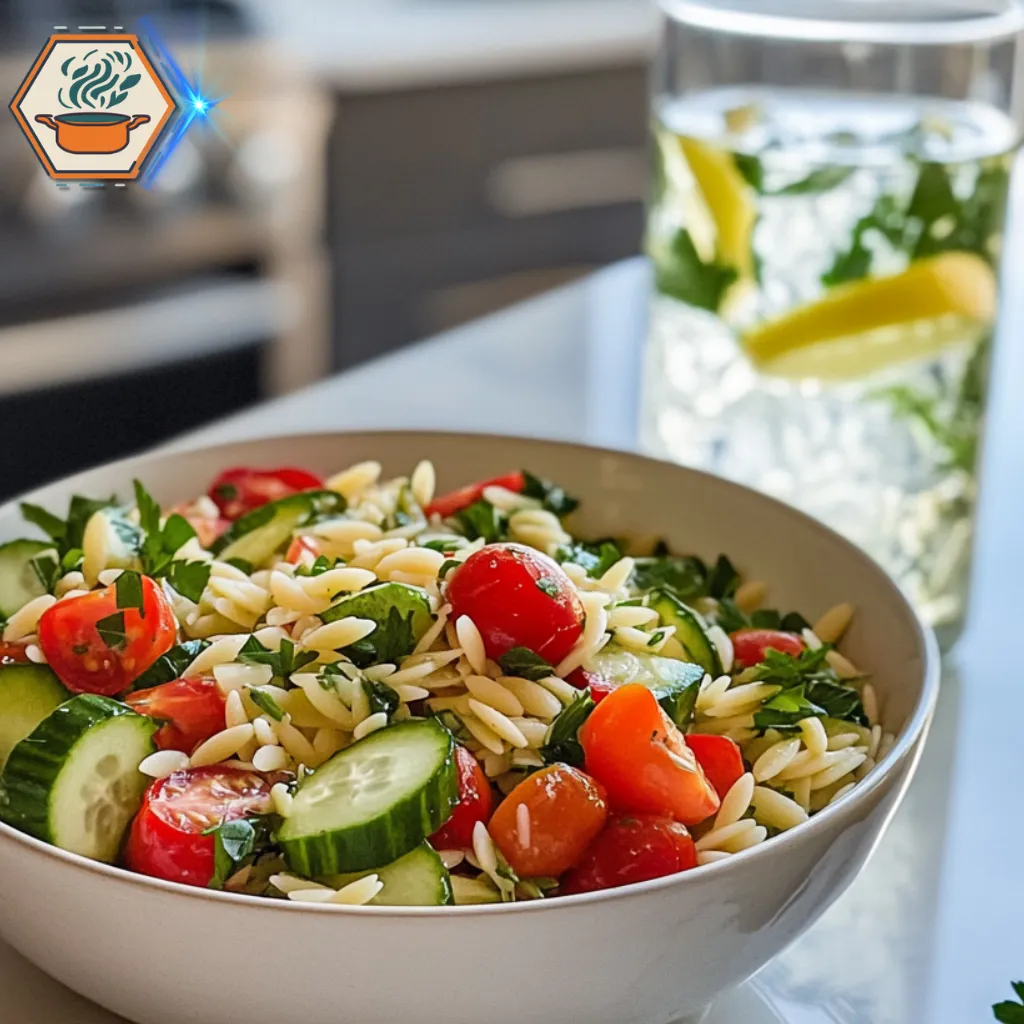
Orzo is known for its delicate texture, making it a popular choice for those with sensitive digestion. Its small size is less filling than heavier pasta options, which can be beneficial when preparing light meals. It pairs well in soups and salads, helping you enjoy meals without feeling overly full.
- Internal Tip: Pair orzo with fresh veggies or lean proteins like grilled chicken or fish for a balanced dish. For example, try it in soups like those discussed in our bone broth preparation guide.
Pairing with Low-Fat and High-Protein Dishes
Orzo’s mild flavor complements low-fat and high-protein ingredients. For instance:
- Toss orzo with chickpeas and spinach for a vegetarian option.
- Use it in high-protein meal bowls featuring turkey or tofu.
Such combinations offer a lower-calorie, nutrient-rich alternative to heavier pasta-based meals.
Benefits of Traditional Pasta
Whole-Grain Varieties and Their Advantages
Traditional pasta comes in whole-grain versions, offering added fiber and micronutrients compared to refined orzo. These options:
- Support heart health.
- Improve digestion due to the high fiber content.
Whole-grain pasta is especially great for individuals aiming to maintain stable blood sugar levels or those on a heart-healthy diet. Explore creative recipes with whole grains to maximize benefits.
High Energy Source for Athletes
For those with high energy demands, traditional pasta is a robust carbohydrate source, perfect for athletes or active individuals. Consumed before intense activity, pasta fuels endurance. Pair it with a light sauce or lean protein to create a meal rich in energy but balanced in nutrients.
Common Drawbacks of Both
Refined Carbs and Their Effect on Health
Both orzo and traditional pasta can be rich in refined carbohydrates when made from white flour. These:
- Can cause quick spikes in blood sugar levels.
- Provide fewer nutrients compared to whole-grain alternatives.
Gluten Content and Alternative Options
Neither orzo nor traditional pasta is naturally gluten-free, which makes them unsuitable for individuals with celiac disease or gluten intolerance. However:
- Gluten-free orzo is available, typically made from rice or corn.
- Alternative pasta options, such as those made with lentils or chickpeas, can also be a smart choice for those seeking variety.
For comprehensive information on gluten-free diets, including their benefits and considerations, you can explore Healthline’s guide on the subject. Healthline
Which to Choose for Specific Diets: Orzo vs Pasta
When deciding between orzo vs pasta for a specific diet, several factors such as nutritional needs, dietary restrictions, and meal goals play a significant role. Both orzo and traditional pasta can cater to different preferences, but understanding their unique characteristics will help you make an informed choice.
Best Option for Weight Loss
For those aiming to lose weight, portion control and the glycemic index (GI) are essential considerations. Orzo and pasta differ in these aspects:
- Portion Control:
Orzo, being smaller in size, often appears denser on a plate, which can psychologically make a smaller portion feel satisfying.
Pasta, especially long types like spaghetti, may be easier to over-serve, leading to higher calorie intake. - Glycemic Index Comparison:
Orzo usually has a moderate glycemic index, which means it causes a slower rise in blood sugar levels compared to some pasta types. Whole-grain pasta has a lower GI than refined versions, making it a better option for steady energy.
For weight loss, choosing whole-grain orzo or whole-wheat pasta paired with plenty of vegetables and lean proteins can enhance satiety and control calorie intake.
Best for a High-Protein Diet
If you’re following a high-protein diet, orzo vs pasta choices should complement your protein intake.
- Pairing with Protein-Rich Foods:
- Orzo works well in soups or salads with chicken, chickpeas, or feta cheese, providing a balanced texture and flavor.
- Pasta pairs excellently with lean ground beef, turkey meatballs, or tofu, creating a hearty and filling meal.
- Specialty High-Protein Versions:
Many brands offer high-protein orzo and pasta made from lentils, chickpeas, or even pea protein. These alternatives boost protein content significantly, making them ideal for fitness enthusiasts or those managing muscle recovery.
Best for Vegetarian and Vegan Diets
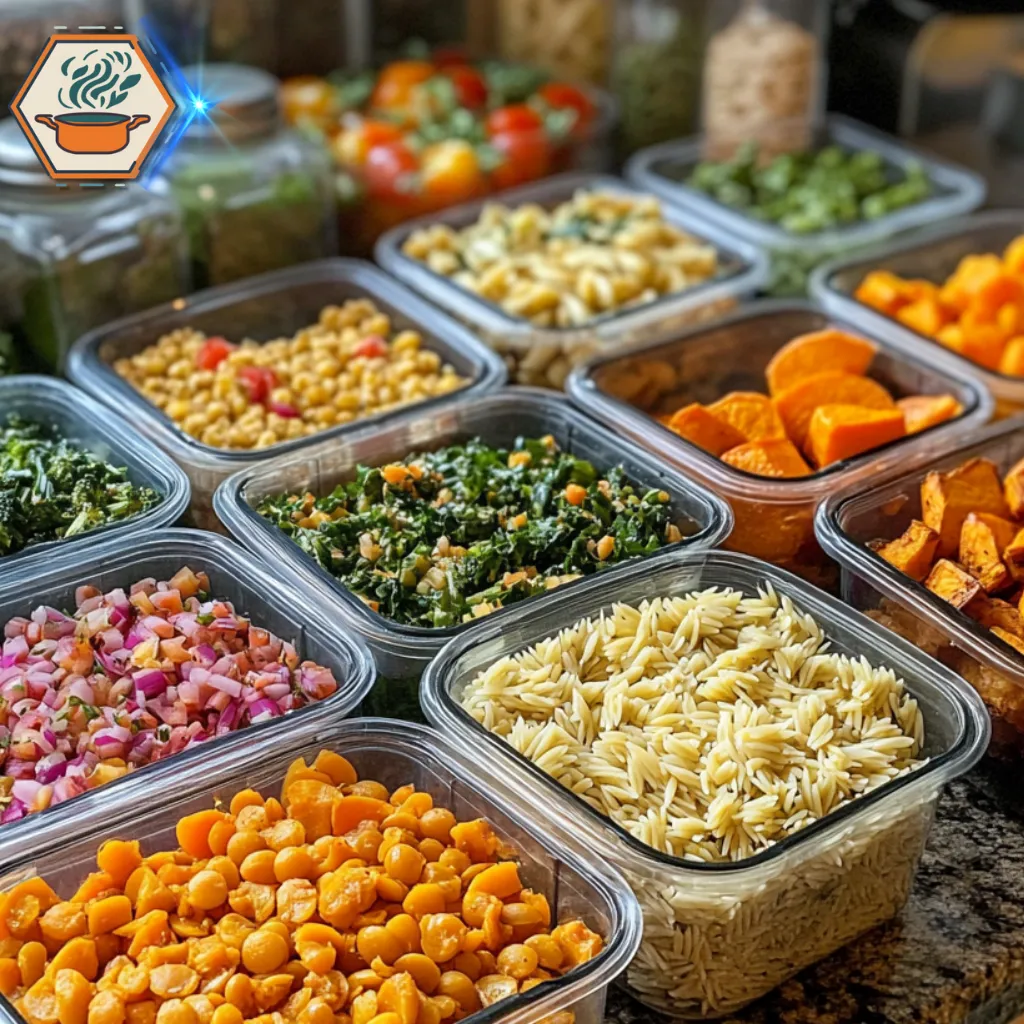
For plant-based eaters, the nutrient balance is crucial when deciding between orzo and pasta.
- Nutrient Balance:
- Orzo made from whole grains offers more fiber, making it an excellent choice for vegan salads with spinach, roasted vegetables, and tahini dressing.
- Pasta provides a base for hearty vegan dishes like pasta primavera or spaghetti with lentil marinara sauce.
- Adding Plant-Based Ingredients:
Combining either option with legumes, nuts, and seeds enhances the meal’s protein and healthy fat profile, ensuring a satisfying and nutrient-dense dish.
Best for Gluten-Free or Low-Carb Diets
If gluten-free or low-carb is a priority, choosing the right alternative is essential when comparing orzo vs pasta.
- Gluten-Free Options:
Orzo alternatives made from chickpea, quinoa, or rice flour are widely available and mimic the texture of traditional orzo.
Gluten-free pasta, on the other hand, comes in a variety of styles, including spirals, penne, and fettuccine, catering to different dish types. - Low-Carb Choices:
Chickpea orzo or zoodles (zucchini noodles) offer lower carbohydrate content, making them better for low-carb diets. Similarly, shirataki pasta is a popular choice for keto and low-carb plans due to its negligible carb content.
Both options work well with low-carb sauces and toppings, such as pesto, garlic butter shrimp, or roasted cauliflower.
Print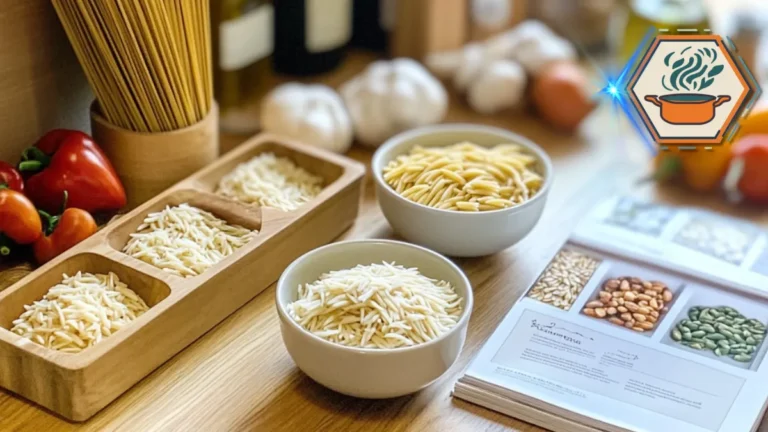
Creamy Orzo Salad with Vegetables
This creamy orzo salad combines tender orzo pasta, fresh vegetables, and tangy feta cheese in a refreshing lemon-garlic dressing. Perfect as a light meal or a side dish, it’s easy to make, packed with flavor, and customizable with your favorite ingredients. Ideal for meal prep, potlucks, or family dinners, this recipe highlights the versatility of orzo pasta. Serve it chilled or at room temperature for a deliciously satisfying dish!
- Total Time: 30 minutes
- Yield: Serves 4-6
Ingredients
Ingredients:
- 1 cup orzo pasta
- 2 cups chicken or vegetable broth (for cooking orzo)
- 1 cup cherry tomatoes, halved
- 1/2 cup cucumber, diced
- 1/4 cup red onion, finely chopped
- 1/4 cup feta cheese, crumbled
- 2 tablespoons fresh parsley, chopped
- 1 tablespoon olive oil
- 1 tablespoon lemon juice
- 1/4 teaspoon garlic powder
- Salt and pepper to taste
Instructions
Instructions:
Cook Orzo:
- Bring the broth to a boil in a medium saucepan.
- Add the orzo and cook for 8-10 minutes until al dente. Drain any excess liquid and let it cool.
Prepare Vegetables:
- Dice the cucumber, halve the cherry tomatoes, and finely chop the red onion.
Combine Ingredients:
- In a large mixing bowl, combine the cooked orzo, vegetables, and feta cheese.
Make the Dressing:
- Whisk together olive oil, lemon juice, garlic powder, salt, and pepper in a small bowl.
Toss and Garnish:
- Pour the dressing over the orzo mixture and toss until evenly coated.
- Garnish with fresh parsley.
Chill and Serve:
- Refrigerate for at least 30 minutes to let the flavors meld. Serve chilled or at room temperature.
Notes
Preparation Tips:
- Substitute feta cheese with goat cheese for a creamier texture.
- Add protein like grilled chicken, chickpeas, or shrimp for a complete meal.
- For a gluten-free version, use gluten-free orzo made from rice or corn.
- Prep Time: 10 minutes
- Cook Time: 20 minutes
- Category: Main Dish, Side Dish
- Method: Stove-Top, Simmering
- Cuisine: Mediterranean
- Diet: Vegetarian
FAQs
1. What is the difference between Orzo and Pasta?
Orzo vs Pasta differs primarily in shape and usage. Orzo is rice-shaped pasta often used in soups and salads, while traditional pasta comes in various shapes like spaghetti or penne for saucy and baked dishes.
2. Is Orzo healthier than Pasta?
When comparing Orzo vs Pasta, both are similar nutritionally. Whole-grain options of both are healthier, offering more fiber and nutrients than refined versions.
3. Can I substitute Orzo for Pasta?
Yes, you can substitute Orzo for Pasta in many recipes. Orzo works well in dishes like soups, risottos, or casseroles, whereas pasta may be better suited for saucy and layered dishes.
4. How does cooking time differ between Orzo and Pasta?
Cooking times for Orzo vs Pasta vary. Orzo usually cooks in 8-10 minutes, while traditional pasta like spaghetti or penne can take 10-12 minutes, depending on the type.
5. Which is better for weight loss: Orzo or Pasta?
In Orzo vs Pasta, whole-grain Orzo and whole-wheat Pasta are both excellent choices for weight loss, as they are higher in fiber and keep you fuller longer.
6. Is Orzo gluten-free?
Traditional Orzo is not gluten-free, as it’s made from wheat. However, gluten-free Orzo made from rice or corn is available for those with dietary restrictions.
7. What dishes can I make with Orzo vs Pasta?
Orzo is ideal for soups, salads, and casseroles, while traditional Pasta is perfect for saucy dishes like spaghetti, lasagna, or baked ziti.
8. What’s the calorie difference between Orzo and Pasta?
Orzo and Pasta have similar calorie counts, around 200 calories per 2-ounce serving. Whole-grain versions of both are lower on the glycemic index and offer more fiber.
9. Can Orzo be used as a rice substitute?
Yes, Orzo’s rice-like shape makes it an excellent substitute for rice in dishes like pilafs and risottos, adding a unique pasta texture.
10. What’s the best way to cook Orzo?
Cook Orzo in salted boiling water for 8-10 minutes, then drain and toss with olive oil, herbs, or your favorite sauce for a delicious dish.

